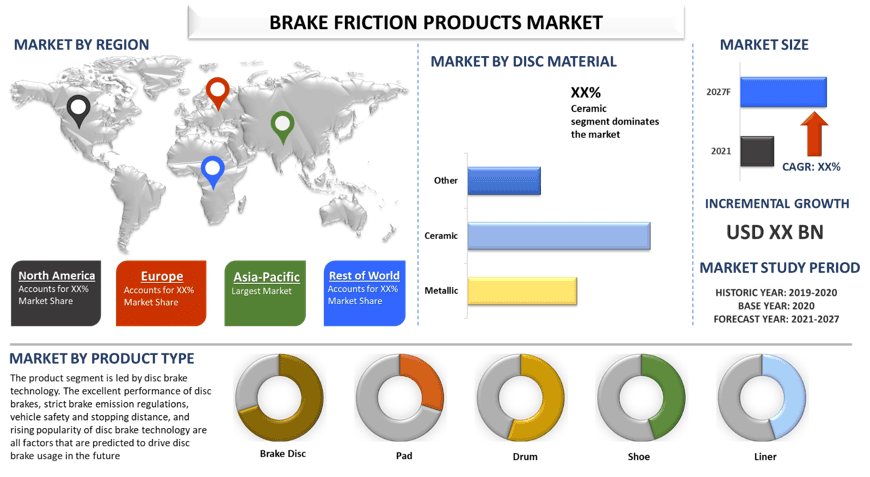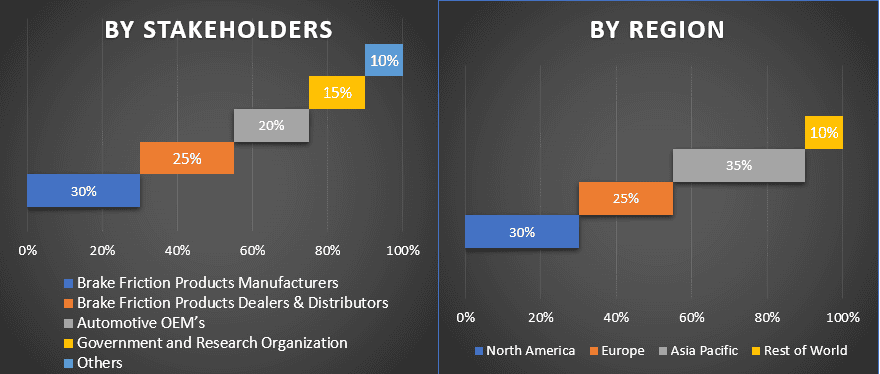- Strona główna
- O nas
- Branża
- Usługi
- Czytanie
- Kontakt
Rynek produktów ciernych hamulców: aktualna analiza i prognoza (2021-2027)
Nacisk na typ produktu (tarcza hamulcowa, klocki, bęben, szczęka, okładzina); Materiał tarczy (metaliczny, ceramiczny, inny); Typ okładziny (formowana, tkana); Typ pojazdu (osobowy, komercyjny); oraz Region/Kraj

Oczekuje się, że globalny rynek okładzin ciernych hamulców wykaże CAGR na poziomie około ~3% w okresie prognozy (2021-2027). Użycie hamulców podczas jazdy wzrasta wraz ze wzrostem zatłoczenia drogowego. Intensywniejsze hamowanie powoduje zużycie klocków hamulcowych i zmniejsza siłę hamowania. Kiedy siła hamowania jest zmniejszona, istnieje silna potrzeba wymiany klocków i szczęk hamulcowych. W rezultacie wymiana hamulców zwiększa zapotrzebowanie na klocki hamulcowe, powodując rozwój rynku okładzin ciernych hamulców. Wprowadzenie hamulców tarczowych w celu poprawy układu hamulcowego w samochodach doprowadziło do wzrostu popytu na samochodowe materiały cierne hamulców, głównie z sektora motoryzacyjnego. Rynek jest napędzany zwiększonym zainteresowaniem samochodami komercyjnymi i osobowymi, co doprowadziło do rozwoju samochodowych materiałów ciernych hamulców do użytku w częściach samochodowych.
Informacje przedstawione w raporcie
„Wśród typów produktów segment tarcz hamulcowych dominował na rynku w 2020 r.”
Na podstawie typu produktu rynek jest podzielony na tarcze hamulcowe, klocki, bębny, szczęki i okładziny. Oczekuje się, że segment tarcz hamulcowych będzie rósł przy wyższym CAGR w prognozowanym okresie. Segment pojazdów jest zdominowany przez technologię hamulców tarczowych. Doskonała wydajność hamulców tarczowych, surowe przepisy dotyczące emisji z hamulców, bezpieczeństwo pojazdów i droga hamowania oraz rosnąca popularność technologii hamulców tarczowych to czynniki, które przewiduje się, że będą napędzać wykorzystanie hamulców tarczowych w przyszłości.
„Wśród materiałów na tarcze segment ceramiczny dominował na rynku w 2020 r.”
Na podstawie materiału tarczy rynek jest podzielony na metaliczne, ceramiczne i inne. Oczekuje się, że segment ceramiczny będzie rósł przy wyższym CAGR w prognozowanym okresie. Metaliczne klocki hamulcowe są głośniejsze niż ceramiczne lub inne klocki hamulcowe, co skutkuje głośniejszą jazdą. Metaliczne klocki hamulcowe wywierają również dodatkowe obciążenie na układ hamulcowy, powodując szybsze zużywanie się tarcz hamulcowych. Ceramiczne klocki hamulcowe są bardziej niezawodne w szerszym zakresie temperatur i warunków jazdy niż metaliczne klocki hamulcowe.
„Wśród typów okładzin segment formowany dominował na rynku w 2020 r.”
Na podstawie typu okładziny rynek jest podzielony na formowane i tkane. Oczekuje się, że segment formowany będzie rósł przy wyższym CAGR w prognozowanym okresie. Ze względu na jego cechy, takie jak trwałość w wydajności, odporność na wodę itp., oczekuje się, że popyt na formowaną okładzinę wzrośnie w prognozowanym okresie.
„Wśród typów pojazdów segment pasażerski dominował na rynku w 2020 r.”
Na podstawie typu pojazdu rynek jest podzielony na pasażerskie i komercyjne. Oczekuje się, że segment pasażerski będzie rósł przy wyższym CAGR w prognozowanym okresie. Szacuje się, że segment samochodów osobowych jest największym i najszybciej rozwijającym się rynkiem produktów ciernych hamulców ze względu na wyższą produkcję samochodów osobowych niż pojazdów komercyjnych. Popyt na samochody osobowe jest bardzo wysoki z krajów takich jak Chiny, Indie, co dodatkowo napędza popyt na produkty cierne hamulców.
„Region Azji i Pacyfiku reprezentuje największy rynek.”
Na podstawie szacunków, w okresie projekcji 2021-2027, oczekuje się, że region Azji i Pacyfiku będzie rósł przy wyższym CAGR. Poprawa warunków społeczno-ekonomicznych rozwijających się krajów, takich jak Chiny, Indie, Indonezja i Tajlandia, może być powiązana z ekspansją. Rynek produktów ciernych hamulców zostanie pobudzony przez rosnącą produkcję pojazdów i przyszłe surowe normy bezpieczeństwa w Chinach i Indiach. Rosnące zapotrzebowanie Chin i Indii na ciężarówki, autobusy, koleje, maszyny przemysłowe i robotykę napędza popyt na materiały cierne w różnych zastosowaniach. Ze względu na znaczący rozwój regionu w branżach motoryzacyjnej i lotniczej, rynek samochodowych materiałów ciernych hamulców w regionie Azji i Pacyfiku rozwija się. Szybki rozwój i rosnący popyt na samochody osobowe napędzają globalny rynek samochodowych materiałów ciernych hamulców. Niektórzy z głównych graczy działających na rynku to Aisin Corporation, Robert Bosch, Nisshinbo Holdings Inc., Brembo S.p.A, Tenneco Inc., Federal-Mogul Corporation, Delphi Technologies, ANAND Group, Akebono Brake Industry Co., Ltd., Miba AG itp.
Powody, dla których warto kupić ten raport:
- Badanie obejmuje analizę wielkości rynku i prognozowania, zatwierdzoną przez uwierzytelnionych kluczowych ekspertów branżowych
- Raport przedstawia szybki przegląd ogólnej wydajności branży na pierwszy rzut oka
- Raport obejmuje dogłębną analizę wybitnych firm z branży, z głównym naciskiem na kluczowe dane finansowe przedsiębiorstw, portfolio produktów, strategie ekspansji i najnowsze wydarzenia
- Szczegółowe badanie czynników napędzających, ograniczeń, kluczowych trendów i możliwości występujących w branży
- Badanie kompleksowo obejmuje rynek w różnych segmentach
- Dogłębna analiza regionalna i krajowa branży
Opcje dostosowania:
Globalny rynek produktów ciernych hamulców można dodatkowo dostosować zgodnie z wymaganiami lub dowolnym innym segmentem rynku. Oprócz tego, UMI rozumie, że możesz mieć własne potrzeby biznesowe, dlatego skontaktuj się z nami, aby uzyskać raport, który w pełni odpowiada Twoim wymaganiom.
Spis treści
Globalny wzrost produkcji pojazdów napędza przemysł materiałów ciernych do hamulców. Układy hamulcowe, które składają się z różnych elementów ciernych do hamulców, są montowane w każdym pojeździe. Na przykład tarczowe układy hamulcowe obejmują tarcze i klocki, natomiast hamulec bębnowy ma szczękę hamulcową i bęben hamulcowy. Rosnące zapotrzebowanie na komfort i wygodę spowodowało wzrost produkcji pojazdów na całym świecie. Ponadto poprawiające się warunki gospodarcze i wzrost populacji spowodowały wzrost produkcji samochodów w kilku lokalizacjach. W rezultacie rynek materiałów ciernych do hamulców wzrósł. Każdy samochód ma układ hamulcowy, który zatrzymuje lub spowalnia pojazd. Wraz ze wzrostem liczby produkowanych samochodów rośnie zapotrzebowanie na elementy hamulcowe, co napędza rozwój branży. Ponadto zwiększone zużycie hamulców zmniejsza rozmiar szczęki hamulcowej, moc i czas wymiany, co powoduje wzrost na rynku materiałów ciernych do hamulców.
Samochodowe produkty cierne do hamulców obejmują wszystkie elementy, które pomagają w zatrzymaniu lub spowolnieniu pojazdu. Samochodowe materiały cierne do hamulców obejmują klocki hamulcowe, bębny hamulcowe, szczęki hamulcowe, tarcze i okładziny. Klocki hamulcowe zwykle mają azbestowy lub półstalowy tylny panel, który przylega do tarczy hamulcowej. Pomagają zatrzymać samochód, przekształcając energię kinetyczną pojazdu w energię mechaniczną. Ponadto dwa klocki hamulcowe są przechowywane w zacisku umieszczonym na tarczy w tarczowych układach hamulcowych. Materiały cierne do hamulców, takie jak szczęka hamulcowa, wypychają się na zewnątrz i zatrzymują ruch obrotowy bębna hamulcowego w hamulcach bębnowych. Producenci zostali zmuszeni do skupienia się na poprawie bezpieczeństwa pojazdów ze względu na rygorystyczne wymagania rządowe i przyjęcie przepisów federalnych. W prognozowanym okresie zwiększy to popyt na samochodowe materiały cierne do hamulców i napędzi wzrost rynku na rynku samochodowych materiałów ciernych do hamulców.
Analiza historycznej wielkości rynku
Krok 1: Dogłębne badanie źródeł wtórnych:
Przeprowadzono szczegółowe badanie wtórne w celu uzyskania historycznej wielkości rynku produktów ciernych do hamulców za pośrednictwem wewnętrznych źródeł firmy, takich jak raport roczny i sprawozdania finansowe, prezentacje wyników, komunikaty prasowe itp., oraz źródeł zewnętrznych, w tym czasopism, wiadomości i artykułów, publikacji rządowych, publikacji konkurencji, raportów sektorowych, baz danych stron trzecich i innych wiarygodnych publikacji.
Krok 2: Segmentacja rynku:
Po uzyskaniu historycznej wielkości rynku produktów ciernych do hamulców przeprowadziliśmy szczegółową analizę wtórną, aby zebrać historyczne informacje o rynku i udziały dla różnych segmentów i podsegmentów dla głównych regionów. Główne segmenty uwzględnione w raporcie dotyczą rodzaju produktu, materiału tarczy, rodzaju okładziny i rodzaju pojazdu. Przeprowadzono dalsze analizy regionalne i krajowe w celu oceny ogólnego przyjęcia rynku produktów ciernych do hamulców w kontekście globalnym.
Krok 3: Analiza czynnikowa:
Po uzyskaniu historycznej wielkości rynku dla różnych segmentów i podsegmentów przeprowadziliśmy szczegółową analizę czynnikową w celu oszacowania bieżącej wielkości rynku. Ponadto przeprowadziliśmy analizę czynnikową przy użyciu zmiennych zależnych i niezależnych, takich jak rosnące zachęty rządowe i popyt na ekologiczny transport itp. Przeanalizowano historyczne trendy i ich wpływ rok do roku na wielkość i udział w rynku. Dokładnie przeanalizowano również scenariusz popytu i podaży.
Szacunek bieżącej wielkości rynku i prognoza
Aktualna wielkość rynku: Na podstawie praktycznych spostrzeżeń z powyższych 3 kroków ustaliliśmy bieżącą wielkość rynku, kluczowych graczy na rynku oraz udziały rynkowe segmentów i firm. Wszystkie wymagane podziały procentowe i podziały rynku zostały określone przy użyciu wspomnianego powyżej podejścia wtórnego i zostały zweryfikowane poprzez wywiady pierwotne.
Szacowanie i prognozowanie: Do szacowania i prognozowania rynku przypisano wagi różnym czynnikom, w tym czynnikom napędzającym i trendom, ograniczeniom i możliwościom dostępnym dla interesariuszy. Po przeanalizowaniu tych czynników zastosowano odpowiednie techniki prognozowania, tj. podejście oddolne, aby uzyskać prognozę rynkową do 2027 r. dla różnych segmentów i podsegmentów w głównych regionach na całym świecie. Metodologia badawcza przyjęta do oszacowania wielkości rynku obejmuje:
- Wielkość rynku branży, pod względem wartości (USD) i wskaźnika przyjęcia produktów ciernych do hamulców na głównych rynkach
- Wszystkie udziały procentowe, podziały i zestawienia segmentów i podsegmentów rynku
- Kluczowi gracze na rynku produktów ciernych do hamulców pod względem oferowanych produktów. Ponadto strategie rozwoju przyjęte przez tych graczy, aby konkurować na szybko rozwijającym się rynku.
Walidacja wielkości i udziału w rynku
Badania pierwotne: Przeprowadzono dogłębne wywiady z kluczowymi liderami opinii (KOL), w tym kadrą kierowniczą najwyższego szczebla (CXO/wiceprezesi, szef sprzedaży, szef marketingu, szef operacyjny i szef regionalny, szef kraju itp.) w głównych krajach. Następnie podsumowano wyniki badań pierwotnych i przeprowadzono analizę statystyczną w celu udowodnienia postawionej hipotezy. Dane wejściowe z badań pierwotnych zostały skonsolidowane z wynikami badań wtórnych, przekształcając w ten sposób informacje w praktyczne spostrzeżenia.
Podział uczestników pierwotnych w różnych regionach

Inżynieria rynku
Zastosowano technikę triangulacji danych w celu ukończenia ogólnego szacowania rynku i uzyskania precyzyjnych danych statystycznych dla każdego segmentu i podsegmentu rynku produktów ciernych do hamulców. Dane podzielono na kilka segmentów i podsegmentów po przestudiowaniu różnych parametrów i trendów w obszarach rodzaju usługi, rodzaju pojazdu i regionu.
Główny cel badania rynku produktów ciernych do hamulców
W badaniu określono aktualne i przyszłe trendy rynkowe dotyczące produktów ciernych do hamulców. Inwestorzy mogą uzyskać strategiczne spostrzeżenia, na których mogą oprzeć swoje decyzje dotyczące inwestycji, na podstawie analizy jakościowej i ilościowej przeprowadzonej w badaniu. Aktualne i przyszłe trendy rynkowe określą ogólną atrakcyjność rynku na poziomie regionalnym i krajowym, zapewniając uczestnikom przemysłowym platformę do wykorzystania niewykorzystanego rynku, aby czerpać korzyści jako pierwsi. Inne ilościowe cele badań obejmują:
- Analizę aktualnej i prognozowanej wielkości rynku produktów ciernych do hamulców pod względem wartości (USD). Ponadto analizę aktualnej i prognozowanej wielkości rynku dla różnych segmentów i podsegmentów
- Segmenty w badaniu obejmują rodzaj, zastosowanie i pojazd
- Zdefiniowana analiza ram regulacyjnych dla globalnej branży produktów ciernych do hamulców
- Analizę łańcucha wartości związanego z obecnością różnych pośredników, wraz z analizą zachowań klientów i konkurentów w branży
- Analizę aktualnej i prognozowanej wielkości rynku produktów ciernych do hamulców dla głównych regionów i krajów
- Główne regiony badane w raporcie obejmują Amerykę Północną (USA, Kanada, Reszta Ameryki Północnej), Europę (Niemcy, Wielka Brytania, Francja, Hiszpania, Reszta Europy), Azję i Pacyfik (Chiny, Japonia, Indie, Korea Południowa, Reszta Azji i Pacyfiku) i Resztę Świata
- Profile firm graczy na rynku produktów ciernych do hamulców i strategie rozwoju przyjęte przez nich w celu utrzymania się na szybko rozwijającym się rynku
- Dogłębna analiza regionalna i krajowa branży
Powiązane Raporty
Klienci, którzy kupili ten przedmiot, kupili również










